
The island fox is a small fox species that is endemic to six of the eight Channel Islands of California. There are six subspecies, each unique to the island it lives on, reflecting its evolutionary history. They are generally docile, show little fear of humans, and are easily tamed. Island foxes played an important role in the spiritual lives of native Channel Islanders. They have been likely semi-domesticated as pets, used as pelts, or for other functions, like pest control.
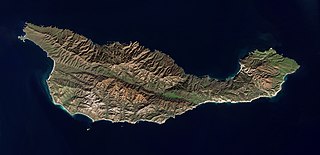
Santa Cruz Island is located off the southwestern coast of Ventura, California, United States. It is the largest island in California and largest of the eight islands in the Channel Islands archipelago and Channel Islands National Park. Forming part of the northern group of the Channel Islands, Santa Cruz is 22 miles (35 km) long and 2 to 6 miles wide with an area of 61,764.6 acres (249.952 km2).

The island scrub jay, also known as the island jay or Santa Cruz jay, is a bird in the genus, Aphelocoma, which is endemic to Santa Cruz Island off the coast of Southern California. Of the over 500 breeding bird species in the continental U.S. and Canada, it is the only insular endemic landbird species.

The island spotted skunk is an insular endemic carnivore and a subspecies of the western spotted skunk. Little is known about their exact variations from the mainland spotted skunk and variations between locations, resolution of which awaits further genetic and morphologic evaluation. The skunk is only currently found on two islands off the southern coast of California. Its presence has been recorded on San Miguel Island, but it has since been declared extinct in that area. The Channel Island skunk is one of two terrestrial carnivores on the islands, the other being the island fox. It is designated as a species of special concern by the state of California.

Thysanocarpus is a small genus of plants in the family Brassicaceae known generally as fringepods or lacepods. These are small, erect annual herbs. The flat fruit capsule is generally round or oval-shaped with a wing that goes all the way around the pod, giving it a fringed look. The fruits hang from most of the length of the stem. The plants are native to the western United States.

Dudleya nesiotica is a very rare succulent plant known by the common name Santa Cruz Island liveforever. This Dudleya is endemic to Santa Cruz Island, one of the Channel Islands of California. This is a squat plant growing in mats on the rocky, exposed ground of the windswept island. It is a federally listed threatened species.
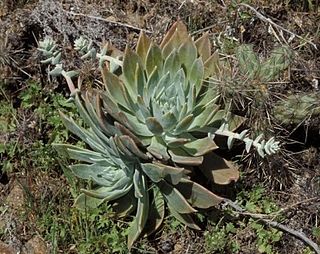
Dudleya traskiae is a rare succulent plant known by the common name Santa Barbara Island liveforever. This Dudleya is endemic to Santa Barbara Island, one of the Channel Islands of California, where it grows on rocky bluffs. The plant has a basal rosette of flat, spade-shaped fleshy leaves up to 15 centimeters long, which are pale green to yellowish. It erects tall stems bearing dense, rounded inflorescences of many bright yellow flowers.

Galium buxifolium is a rare species of flowering plant in the coffee family known by the common names box bedstraw and island bedstraw. It is endemic to the Channel Islands of California, where it is known from about 26 populations on two of the islands. It is a federally listed endangered species of the United States.
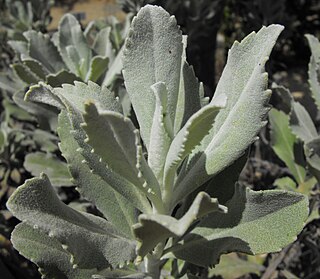
Hazardia detonsa is a rare species of shrub in the family Asteraceae known by the common name island bristleweed. It is endemic to the Channel Islands of California, having been found on 4 islands.

Crocanthemum greenei is a rare species of flowering plant in the rock-rose family known by the common name island rush-rose. It is endemic to the Channel Islands of California, where it grows in the chaparral of the rocky seaside slopes. It is present on three of the eight islands, where it has historically been threatened by feral herbivores such as the Santa Cruz sheep and is making a gradual recovery. It is a federally listed threatened species.

Boechera hoffmannii is a rare species of flowering plant in the family Brassicaceae known by the common name Hoffmann's rockcress. It is endemic to the Channel Islands of California, where it is known from only three or four populations on two of the eight islands. A 2005 report estimated a remaining global population of 244 individual plants. It is a federally listed endangered species.
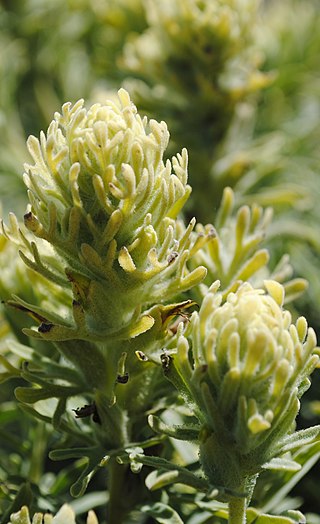
Castilleja grisea is a rare species of Indian paintbrush known by the common name San Clemente Island Indian paintbrush. It is endemic to San Clemente Island, one of the Channel Islands of California. San Clemente Island is owned by the US Navy so the Navy is involved in a management program to recover this species.
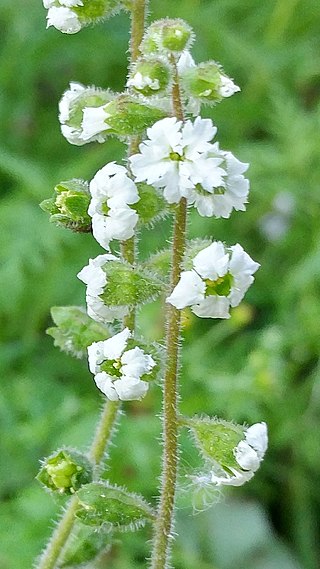
Lithophragma maximum, known by the common name San Clemente Island woodland star, is a rare species of flowering plant in the saxifrage family. It is endemic to San Clemente Island, one of the eight Channel Islands of California. It is known from only about four kilometers of rocky coastal cliffs on the edge of the island. The plant was thought to be extinct until a few specimens were rediscovered in 1979. Only 200 individuals were tallied in a 1996 survey. In 1997 the plant was listed as an endangered species on the federal level.

Malacothamnus clementinus is a rare species of flowering plant in the mallow family known by the common name San Clemente Island bushmallow. It is endemic to San Clemente Island, one of the Channel Islands of California, where it is known from fewer than ten occurrences in the steep, rocky seaside canyons.
Malacothrix indecora is a rare species of flowering plant in the family Asteraceae known by the common name Santa Cruz Island desertdandelion. It is endemic to the Channel Islands of California, where it is known from only a few populations on three of the eight islands. As of 2000, there were three occurrences on San Miguel Island, two on Santa Rosa Island, and one on Santa Cruz Island. It grows on the bluffs and rocky coastal grasslands of the islands. Like many Channel Islands endemics, this plant is naturally limited in distribution and has been threatened by the presence of destructive introduced mammals, in this case, feral pigs. The plant became a federally listed endangered species in 1997. This is a mat-forming annual herb which spreads low to the ground no more than about 10 centimeters high. The fleshy leaves have dull lobes. The inflorescence is an array of flower heads lined with oval-shaped phyllaries. The ray florets are under a centimeter long and yellow in color.

Sibara filifolia, the Santa Cruz Island winged rockcress or Santa Cruz Island rockcress, is a rare species of flowering plant in the family Brassicaceae. It is endemic to the Channel Islands of California, where it is now known from a few occurrences on San Clemente Island and one population on Catalina Island.
Trifolium buckwestiorum is a rare species of clover known by the common name Santa Cruz clover.

Triteleia clementina is a rare species of flowering plant known by the common name San Clemente Island triteleia. It is endemic to San Clemente Island, one of the Channel Islands of California, where it is known from about twenty occurrences. Its habitat includes moist, rocky, seaside grassland. It is a perennial herb growing from a corm. It produces two or three keeled, lance-shaped leaves up to 100 centimeters long by three wide. The inflorescence arises on an erect stem up to 90 centimeters tall and bears an umbel-like cluster of many flowers. Each flower is a funnel-shaped lavender or light blue bloom with six lobes measuring up to 1.5 centimeters long. There are six stamens with purple anthers.

Cyperus pennatiformis is a rare species of sedge known by the common name coastal flatsedge. It is endemic to Hawaii, where it grows on the islands of Maui, Kauai, and Laysan. It is a federally listed endangered species of the United States.

Sanicula purpurea is a rare species of flowering plant in the carrot family known by the common names purple-flower black-snakeroot and purple-flowered sanicle. It is endemic to Hawaii, where it is known from Maui and from the Koolau Mountains on the island of Oahu. It is threatened by the degradation of its habitat. It was federally listed as endangered species of the United States in 1996.



















